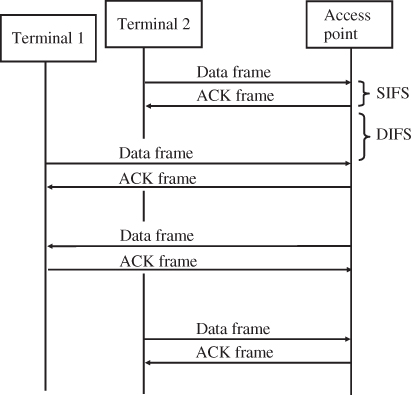6.5 The MAC Layer
The MAC protocol on layer 2 has similar tasks in a WLAN as in a fixed-line Ethernet:
- It controls access of the client devices to the air interface.
- A MAC header is put in front of every frame that contains, among other parameters, the (MAC) address of the sender (source) of the frame and the (MAC) address of the recipient (destination).
6.5.1 Air Interface Access Control
As the air interface is a very unreliable transmission medium, a recipient of a packet is required to send an acknowledgment (ACK) frame to inform the sender of the correct reception of the frame. This is a big difference from a wired Ethernet, where frames are not acknowledged. In all previous figures in this chapter, ACK frames were not shown for easier interpretation of the content. Figure 6.11 shows for the first time how frames are exchanged between a client device and an access point including the ACK frames. Each frame, regardless of whether it contains user data or management information (authentication, association, etc.), has to be acknowledged with an ACK frame. The same or a different client device is allowed to send the next frame only when the ACK frame has been received. If no ACK frame is received within a certain time, the sender assumes that the frame was lost and thus resends the frame.
Figure 6.11 Acknowledgment for every frame and required interframe space periods.

To ensure ...
Get From GSM to LTE: An Introduction to Mobile Networks and Mobile Broadband now with the O’Reilly learning platform.
O’Reilly members experience books, live events, courses curated by job role, and more from O’Reilly and nearly 200 top publishers.

